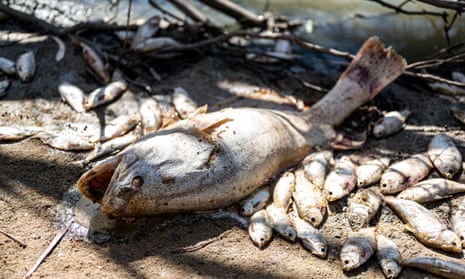Murray cod – a native fish classified as a vulnerable species – have virtually disappeared from the New South Wales’ Lower Darling, pointing to an environmental crisis following 2019 and 2023 fish kills in that part of the river.
A survey by NSW Fisheries undertaken in May has revealed the scale of the impact on fish populations, showing attempts at repopulating the river after the 2018-19 drought appear to have failed.
The survey was undertaken after a major blackwater event in March that killed millions of fish, mainly bony herring but also perch and Murray cod.
It found that the numbers of Murray cod were “substantially lower” when compared with preceding years.
No cod were captured at sites upstream from Weir 32 near the top of the Menindee Lakes system, although the report noted that anglers had reported capturing some in this part of the river.
They were captured in “low abundance” in the 200kms of river downstream between Menindee and Pooncarie, and all were below 500mm in size and sub-adult, the report said.
Adult Murray cod can grow to a well over a metre long and can live for 70 years. During the drought of 2019, large fish were left gasping for breath in shallow pools after the Lower Darling-Baaka (LDBR) ceased to flow for more than eight months. Hundreds of thousands of fish died during hot weather.
A bigger fish kill event followed in March this year in which millions of bony herring and other species died after floods hit the region in January 2023.
The runoff from the flood plains, which had not been inundated for years, caused poor water quality and deoxygenation, known as “blackwater”.
The Fisheries survey also found sharp drops in the number of silver perch, another native species that was already becoming rare. Only six were detected between 2019 and 2021. In the May survey, only two fish were detected, both in the Menindee town weir pool.
The Guardian reported on the yet-to-be released fish survey earlier this month, which has prompted local communities to call for embargos on agricultural use of water and immediate action to restore flows to the river ahead of summer.
“Large-scale, extreme changes in flow conditions – from zero flow to major flooding in the space of four years – pose significant and ongoing risks and challenges to native fish,” the Fisheries report said.
after newsletter promotion
“Such extreme changes represent a departure from the natural flow regime in the Lower Darling Baaka, which were typified by [being] within channel flow variability throughout the majority of years, punctuated by larger floods and occasional short cease-to-flow events,” the report said.
The report found that pest species like carp and goldfish have increased since the recent flooding and fish death events, further adding to the ecological problem.
Between Weir 32 and Menindee main weir – from where the town draws its water – the survey found there are more bony herring than in 2019, which could lead to more fish kills as the summer approaches.
The report scientists have urged major changes to managing the river to reverse the damage.
“It will be crucial to adaptively manage and conserve native fish and their habitats by using the best available knowledge,” the report said.
“The long-term sustainability of native fish populations in the LDBR is dependent on a variable but perennial flow regime that supports the life history needs (spawning, breeding habitat, growth and dispersal) of different species.”
